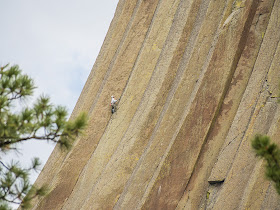 |
| Climbing Devil's Tower, Wyoming (Final Composition) |
The thing I like best about mirrorless interchangeable lens cameras (MILC) is not their smaller size, lessor weight, more favorable impact on my wallet or even the electronic viewfinder. What is it? When those cameras lock on focus, it is dead on. That is what I love most.
Unlike SLRs with phase detection autofocus (PDAF) which use separate focusing sensors, the contrast detect autofocus (CDAF) of mirrorless cameras focus directly off the front of the sensor. It focuses at the exact plane where the image will be recorded. There is no need to buy focus testing gadgets, software or run camera and lens combinations through extensive testing to ensure the best focus is achieved due to difference in camera/lens tolerances. Now, I know contrast detect doesn't do as well with tracking or moving objects, but it is getting there quickly. Each generation of mirrorless is much better than the last at continuous or tracking focus. My E-M1 is pretty doggone good and, I suspect, the next generation cameras will pretty much equal SLRs.
That assurance that the focus is dead on is a really nice feeling! I have never had to second guess my mirrorless cameras when it comes to focus. When you see lock on, it is locked on exactly.
The image above is an example. I spotted this climber up on Devil's Tower in Wyoming. He was a speck and I almost didn't see him. He was probably 600-700 ft. above the ground around the Tower. I had my Nikon D800e with me but the longest lens I have for that was the Nikon 70-200 F/2.8 VRII (at the time; I now have the 70-200 F/4 VR). I could have used a 1.4X or 2X high quality Nikon Tele-Converter, but I felt that would not produce as good as image quality as I could get with my M4/3 system, specifically the E-M5.
 |
| Climber on Devil's Tower, Wyoming (Full Image) |
So, I used my Olympus E-M5 with the Panasonic 100-300 mm lens, which, I admit, is not the absolute the best quality, but I have found it to be certainly usable. I zoomed all the way to 300mm, which is 600mm equivalent in 35mm terms. The shutter speed was 1/500th second and the aperture F/7.1 Since I wasn't in a place to use a tripod, so this image was made handheld. Here is the full image as recorded.
It doesn't show up well in the full image, but at 1:1, you can easily see that the camera locked in on the climber and rocks with no focus error.
As you all know, it is really hard to tell on an LCD what the final quality of an image will be, even with zooming the image in all the way. So, I walked away pretty confident that I had made a nice image and I was certainly confident that the focus was dead on.
Here is a 1:1 version showing the climber. You may disagree, but I believe the camera nailed the focus! I'm not sure a phase detect system would have focused this accurately on a pretty low contrast scene such as this. And--that is why I have complete confidence in the contrast detect focusing operation of mirrorless camera systems and why it is my most favorite feature of MILCs!
 |
| Climber on Devil's Tower, Wyoming (1:1) |
Dennis Mook
Many of my images can be found at www.dennismook.com. Please pay it a visit. I add new images regularly. Thank you.
All content on this blog is © 2014 Dennis A. Mook. All Rights Reserved. Feel free to point to this blog from your website with full attribution. Permission may be granted for commercial use. Please contact Mr. Mook to discuss permission to reproduce the blog posts and/or images.
No comments:
Post a Comment